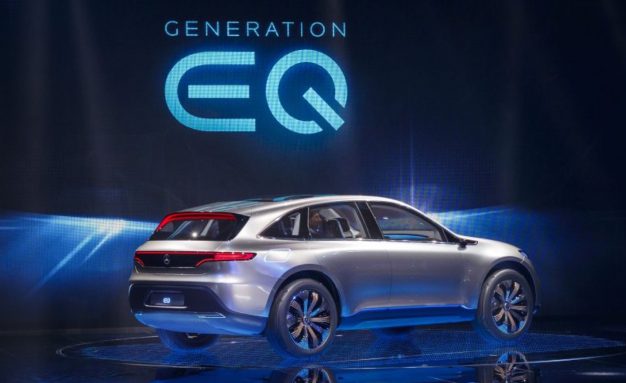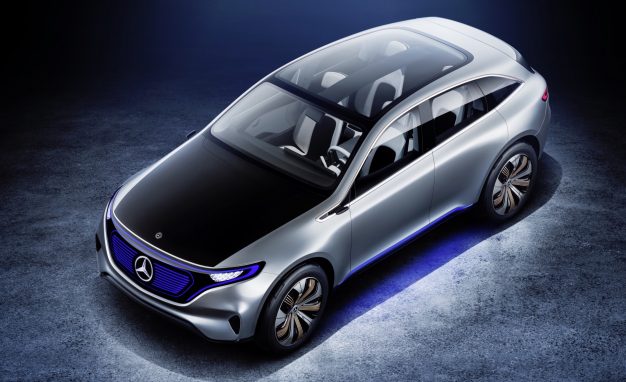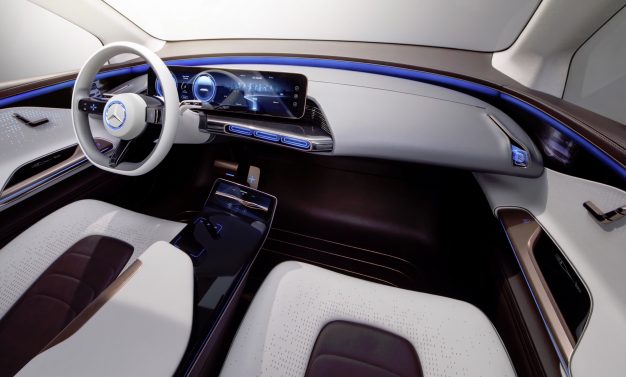 Mercedes-Benz, with the introduction of an entire new sub-brand called EQ—teased by this Generation EQ concept from the Paris auto show earlier this fall—is committing to electric vehicles for the long haul. The launch of Mercedes-Benz’s first EQ model won’t happen until calendar year 2019—almost three years out. In the meantime, there’s much work to be done to put the new sub-brand on the map, not just with the electric vehicles themselves but with the apps, connectivity, and the interface.
Mercedes-Benz, with the introduction of an entire new sub-brand called EQ—teased by this Generation EQ concept from the Paris auto show earlier this fall—is committing to electric vehicles for the long haul. The launch of Mercedes-Benz’s first EQ model won’t happen until calendar year 2019—almost three years out. In the meantime, there’s much work to be done to put the new sub-brand on the map, not just with the electric vehicles themselves but with the apps, connectivity, and the interface.
–
That’s where the whole EQ ecosystem comes into play. Just in case you’ve been living in a Westfalia and still use a flip phone, no, “ecosystem” doesn’t mean we’re talking about annual rainfall, soil erosion, and a delicate balance of species, but rather a holistic, Apple-like integration of it all. It’s no longer the exception but the expectation that everything will work in harmony: hardware and software, car and smartphone, driving and being driven, owning and sharing. Every company is talking ecosystem nowadays—so much so that there are even wannabe automakers who are boasting about their vehicle ecosystem long before they offer a car.
–
There will be plenty of EQ ecosystem to tease in addition to the cars, we learned in a recent interview with Mercedes Cars’ vice president of sales and product management, Matthias Lührs. And while EQ will offer a different user experience, the vehicles themselves are seen as a natural extension of Mercedes-Benz’s electrification strategy, according to Lührs, so the first step toward EQ will be the introduction of plug-in-hybrid versions of every single vehicle in the Mercedes-Benz model range by 2020. “From next year onward, we’ll have 10 vehicles as such—the broadest model range of plug-in hybrids in the luxury market,” he said. “And we see huge customer demand in that respect.”
–
Lührs said the success of EQ—and the effort ramping up to it—depends on three things: customer demand, infrastructure, and regulations. “We see that more customers are asking for electric vehicles, but the total number is still very small—between 2 and 5 percent of the market.”
–
 Although the automaker is calling EQ a sub-brand, it won’t be limited to just a core model or two like BMW’s i sub-brand. Following the GLC-sized electric crossover—the EQC, we’ll call it—the EQ range will be expanded with a new model about every year after that, according to Lührs, effectively becoming a full-line brand. Some of them will ride on conventional platforms, while others will have shared underpinnings with Mercedes-Benz models; all of them will have distinct sheetmetal and EQ-exclusive interior layouts. “In all, we’re planning to have 10 all-electric vehicles in the next eight or nine years,” he said.
Although the automaker is calling EQ a sub-brand, it won’t be limited to just a core model or two like BMW’s i sub-brand. Following the GLC-sized electric crossover—the EQC, we’ll call it—the EQ range will be expanded with a new model about every year after that, according to Lührs, effectively becoming a full-line brand. Some of them will ride on conventional platforms, while others will have shared underpinnings with Mercedes-Benz models; all of them will have distinct sheetmetal and EQ-exclusive interior layouts. “In all, we’re planning to have 10 all-electric vehicles in the next eight or nine years,” he said.
–
Among the major German automakers, Volkswagen Group and BMW have made major investments to help bolster and support existing U.S. vehicle-charging networks. Mercedes-Benz hasn’t made any such commitments yet and will need a charging solution to bring into its EQ brand, but it’s something Lührs can’t discuss at this point.
–
“Obviously, in this industry, everyone—including Tesla—is still learning, and so everybody is still talking to everybody,” conceded Lührs. “It’s too early to say that this has already been decided and we’re only talking to this supplier or that.”
–
And, of course, the ecosystem does have to fit in here somewhere. “Connected vehicles, autonomous vehicles, shared services, we call it an ecosystem . . . we see interdependencies,” summed up Lührs, who pointed to those as core ideas for the EQ brand. And we might see some signs of that ecosystem—in the form of EQ-branded home-charging hardware, or perhaps an app, prior to the GLC-sized all-electric crossover that will arrive in 2019.
–
 Although the sharing aspect of the EQ brand won’t fully take form for a few years, it will most definitely gather from Daimler’s experience with its car-sharing subsidiary Car2Go—which now competes with BMW’s ReachNow and GM’s Maven, among others, and will soon face Volvo’s Lynk & Co, itself a sub-brand of stand-alone sharing-oriented vehicles. “With Car2Go, we are one of the pioneers—if not the pioneer—also with pure electric vehicles [with the Smart Fortwo Electric Drive in some markets],” said Lührs. “We will further expand on that, and with the Car2Go brand we have a very good field where we can test and see what customers are preferring, and then hopefully build on that, and that is part of the whole ecosystem of EQ.
Although the sharing aspect of the EQ brand won’t fully take form for a few years, it will most definitely gather from Daimler’s experience with its car-sharing subsidiary Car2Go—which now competes with BMW’s ReachNow and GM’s Maven, among others, and will soon face Volvo’s Lynk & Co, itself a sub-brand of stand-alone sharing-oriented vehicles. “With Car2Go, we are one of the pioneers—if not the pioneer—also with pure electric vehicles [with the Smart Fortwo Electric Drive in some markets],” said Lührs. “We will further expand on that, and with the Car2Go brand we have a very good field where we can test and see what customers are preferring, and then hopefully build on that, and that is part of the whole ecosystem of EQ.
–
- –
- Mercedes-Benz Sub-Brand for Electric Models to Start with 310-Mile EV
- Mercedes Gen. EQ Concept: The All-Electric Future Is Now, But Not Quite Yet
- Mercedes Design Boss Dishes on Generation EQ and Future EV Sub-Brand
–
–
–
–
“Imagine one day—let’s say, at the latest, in 2025—there might be a new EQ S-class coming around the corner, and you’re calling it through your EQ app. The car will be picking you up, driving autonomously in the garage, and then picking up the next person. We’re talking about car sharing here—fewer cars on the road, a very friendly ecosystem, and very convenient. You don’t have to call Uber. You call your EQ.”
–
What Lührs described sounds remarkably close to the vision of, well, almost every other automaker nowadays. But with Mercedes-Benz’s luxury pedigree and its well-earned reputation for engineering, innovation, and fully baked active-safety technology, EQ might translate to a full ecosystem like no other.
–




